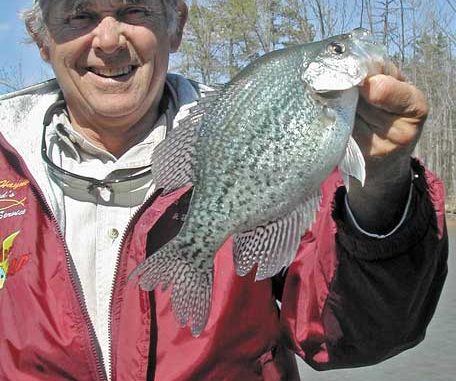
Savvy fisherman can take advantage of Lake Murray crappie closing in on the spawn.
Spring is in the air, and crappie are in the creeks getting ready to spawn or already bedding, making it an outstanding time to challenge Lake Murray’s 50,000 acres.
Crappie will start to spawn on Lake Murray as the water temperature gets up into the 50s — which usually means March, unless the winter has been unusually harsh.
Three veteran fishermen who know Murray’s slab crappie intimately are Marc Danque of Chapin, Frank Bristol of Batesburg and Arthur Draft of Lexington. Danque is a frequent winner of crappie tournaments who owns The Crappie Hole in his hometown. Bristol is a long-time Lake Murray slab-catcher, and Draft is a 41-year-old guide who also excels at catching crappie and striped bass.
Danque and Bristol prefer to greet the spring in Murray’s upper reaches.
“Fish the upper end of Lake Murray for crappie in March because the water warms up there first,” Danque said. “Fish will be in the creeks. Start out fishing in 15 feet of water and adjust your efforts up or down until a pattern develops.”
Depending on the weather, the water temperature, lake level and water clarity, crappie will be somewhere between the mouth to the extremely shallow back end of the creeks. Pay attention to underwater humps and long points, which concentrate crappie.
Drifting with live minnows, trolling with jigs, or fishing a jig with a lip-hooked minnow for a trailer are all options. Danque suggested that the best bet for March is to drift of slow-troll.
“The Bear Creek area on up to both the Big Saluda and Little Saluda rivers is prime water. Under normal conditions, crappie will be spawning in March,” said Danque, a past series champion on the Southern Crappie Association trail. “If the water is clear, I like to use white with chartreuse or blue and silver jigs. Muddy water dictates black and blue jigs, along with black and chartreuse. Green and orange work well in muddy water, too.”
Access areas are fairly close to most prime fishing spots. When fishing the Bear Creek area, Putnam’s Landing is a good launching spot. When fishing farther upriver, Little River Marina is convenient. Dreher Island State Park is between these two.
Danque also suggested that in water temperatures of 45 degrees or less, fishermen need to fish extremely slowly. Crappie are not as active in cold conditions. When fishing with jigs, tipping the jig with a small minnow seems to help the bite rate.
The type cover you fish is also important, according to Danque. He uses his electronics to zero in on brush piles, although he doesn’t plant any himself. He said that it’s difficult to troll through standing timber, but stumps or stump fields make excellent spots for crappie. These can be trolled without too much danger of losing gear.
Bristol starts out around Rocky Creek, both Saluda rivers and Buffalo Creek. “I’m hitting this part of the lake because that’s where the water temperature is the warmest,” said Bristol, who uses Holland’s Marina as an access area.
When the weather has been unusually cold, Bristol advises anglers to fish a little deeper and a little slower. The slower you troll, the deeper your jig will run. Smaller-diameter lines, jig weight and the distance behind the boat also affect how deep the jig will run.
Draft, 41, has been guiding for 18 years. Unlike Danque and Bristol, he prefers to spend March on the lower end of the lake, from the dam upstream to Bear Creek. He touts Bear Creek as one of the best springtime destinations on Lake Murray.
Draft will concentrate his efforts on 15- to 20-foot water depths, from the mouth of creeks on back to the shallows. Depending on water temperatures, crappie will be spawning or will spawn soon.
Draft not only trolls, but he also fishes a system of brushpiles in the lake in a 24-foot Sea Pro. He relies heavily on his electronics to gauge his speed, water depth, fish and bait concentrations. Normally, he trolls 1½ mph, using not only his speedometer to dictate the speed, but also how the fish bite.
His trolling speed may change as the day progresses. When time between strikes increases, changing speed, jig colors or locations are all part of the mix Draft (803-356-2286) has to employ.
When trolling, he uses up to 18 rods. He can fish up to four people comfortably on his boat, with each fishermen responsible for four rods. When a crappie strikes, Draft is a firm believer in not setting the hook, but just to start reeling. Crappie have paper-thin mouths and a strong hookset tends to tear the hook out of the fish’s mouth. The limber-tipped rods Draft uses will let the jig’s hook penetrate a crappie’s mouth without tearing a big hole.
Draft also employs a long-handled net to bring the catch into the boat.
“It’s amazing how many crappie will be lost in the process of landing a fish when a net is not used,” said Draft, who believes that crappie will wear a large hole at the spot of the hookset while trying to get away. “This is doubly true if it flops much on the surface while reeling the fish in.”
Draft uses both artificials and live baits. Generally, he fishes rubber and hair jigs during the winter and live tuffies or shiners the rest of the year. Sometimes, crappie prefer a lip hooked minnow on the back of a jig; he lets the fish determine what they want on a given day. When using jigs, chartreuse, pink and white are his go-to color preferences.
When fishing the lower end of Lake Murray, Draft suggests using Jake’s Landing, which is located just south of the dam off Hwy 6.

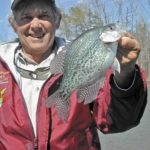
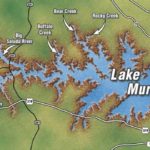
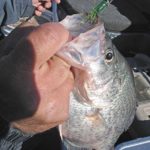
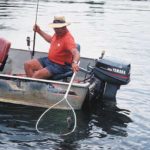


Be the first to comment